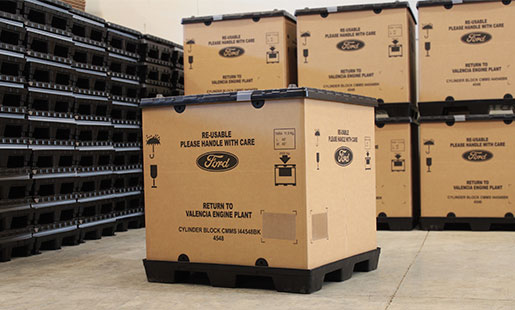Eco-Friendly Practices: Driving Adjustment with Bulk Container Recycling
Wiki Article
Effective Industrial Recycling Solutions for Sustainable Product Packaging: A Comprehensive Guide
In today's significantly environmentally-conscious globe, the demand for sustainable product packaging services has actually never been greater. To meet this need, businesses across sectors are actively looking for reliable industrial recycling services. Nevertheless, browsing the complicated landscape of lasting packaging can be challenging without a detailed guide. That's where this detailed guide on efficient industrial recycling options for lasting product packaging comes in. By exploring key areas such as packaging material choice, creating for recyclability, executing reusing framework, teaming up with recycling companions, and monitoring and determining reusing success, this overview will certainly furnish you with the knowledge and devices required to make educated choices and drive favorable adjustment within your organization. Whether you're a packaging professional, sustainability supervisor, or just thinking about the topic, this guide will offer valuable understandings and techniques to aid you navigate the globe of lasting packaging.Packaging Product Choice
The option of packaging products plays a critical function in making certain the sustainability of industrial recycling services. The choice of materials is essential in lessening ecological impact and taking full advantage of recycling efficiency when it comes to sustainable product packaging. Choosing the ideal products can help in reducing waste generation, preserve sources, and advertise a round economic situation.Materials like cardboard, paper, glass, and particular types of plastics can be recycled several times without losing their top quality. On the other hand, materials that are hard to reuse, such as combined plastics or non-recyclable compounds, can produce difficulties for the reusing procedure and may end up in landfills or incinerators.
Another factor to consider is using sustainable and naturally degradable materials. Packaging made from renewable resources, such as plant-based plastics or biopolymers, can aid decrease reliance on nonrenewable fuel sources and mitigate climate modification. Additionally, naturally degradable products damage down naturally over time, minimizing the build-up of waste in land fills.
Additionally, the weight and quantity of packaging materials must be decreased to decrease transportation expenses and power consumption. Lightweight materials not only require fewer resources throughout production however additionally add to reduce carbon emissions during transportation.
Creating for Recyclability
In order to ensure the recyclability of product packaging materials, thoughtful style is essential. Creating for recyclability involves producing packaging that can be easily sorted, separated, and processed in recycling facilities. One essential element of creating for recyclability is the option of products. Product packaging developers must prioritize using materials that are commonly accepted for reusing and have developed reusing facilities. Products such as glass, aluminum, and certain kinds of plastic, like pet dog and HDPE, are typically recycled and ought to be preferred over products that are costly or hard to reuse.An additional essential factor to consider in creating for recyclability is the elimination of unneeded parts or products. By decreasing the variety of layers, finishings, and additional elements, product packaging can be made simpler and easier to reuse. Additionally, designers ought to aim to lower making use of combined materials, as they can make complex the recycling procedure.

Implementing Recycling Infrastructure
Reliable implementation of reusing infrastructure is crucial for the success of commercial reusing options. Without appropriate framework in position, the recycling procedure ends up being inadequate and inefficient, preventing the overall objective of sustainable packaging.To carry out reusing framework successfully, several essential variables need to be taken into consideration. There ought to be an efficient collection system that assists in the splitting up and collection of recyclable products. This can include designated recycling bins in public areas, along with partnerships with waste administration business for curbside pickup and sorting.
As soon as accumulated, the recyclable products need to be delivered to reusing facilities in a timely way. This needs reliable logistics and transport networks, guaranteeing that the products get to the ideal centers without delay.
At the recycling centers, progressed sorting and handling modern technologies should be in area to separate different types of materials efficiently. This consists of making use of automated sorting devices, optical scanners, and hands-on sorting methods.
Additionally, there must be a durable market need for my sources recycled products. This can be attained through cooperations with suppliers and sectors that make use of recycled products in their manufacturing procedures. Producing a steady market for recycled materials incentivizes the reusing sector and advertises the circular economic climate.
Working Together With Recycling Partners

One key aspect of teaming up with recycling partners is the establishment of clear communication networks. It is essential to establish open lines of interaction to assist in the exchange of info, updates, and feedback. This permits both parties to stay educated regarding the progress of reusing campaigns and resolve any kind of obstacles or issues that might occur.
Furthermore, collaboration can include joint initiatives in implementing and designing reusing programs. Recycling partners can provide useful understandings and assistance in creating reliable collection systems and identifying one of the most appropriate recycling modern technologies. By working together, companies and recycling partners can maximize the reusing process and decrease waste.
Additionally, partnership can extend past the operational elements of recycling. It can also include campaigning for and education initiatives. By joining pressures, businesses and recycling companions can increase understanding about the importance of recycling and advertise the fostering of lasting product packaging techniques amongst consumers and official site other stakeholders.
Monitoring and Measuring Recycling Success
To make certain the effectiveness of industrial recycling options and the success of lasting product packaging objectives, it is vital for organizations and their recycling partners to establish a thorough system for monitoring and measuring recycling success (plastic container manufacturer). Tracking and gauging reusing success permits businesses to evaluate the effect of their reusing initiatives, recognize locations for renovation, and established meaningful targets for future developmentOne method to track recycling success is through using data collection and evaluation tools. By gathering information on the quantity of packaging waste created, the percentage of waste that is reused, and the kinds of products being reused, services can obtain important insights right into their recycling performance. This information can after that be assessed to recognize fads, patterns, and locations of inefficiency.
Another essential facet of monitoring and measuring recycling success is establishing clear and standardized metrics. This enables companies to contrast their efficiency against sector criteria and track their progression over time. Metrics such as reusing rates, waste diversion prices, and greenhouse gas emissions can give a measurable action of a service's reusing success.

Final Thought
In conclusion, executing reliable industrial recycling options for sustainable product packaging needs cautious consideration of product packaging product choice, making for recyclability, implementing reusing infrastructure, working together with reusing partners, and monitoring and determining recycling success. By integrating these methods, businesses can add to a more environmentally-friendly and sustainable technique to packaging, browse this site reducing waste and advertising the circular economic situation.By checking out vital areas such as packaging product choice, making for recyclability, implementing reusing infrastructure, teaming up with recycling partners, and tracking and gauging recycling success, this guide will outfit you with the expertise and devices necessary to make educated choices and drive positive modification within your organization. Packaging designers need to prioritize the use of products that are extensively approved for recycling and have developed recycling facilities.Cooperation with recycling companions is vital for the effective implementation of industrial reusing remedies and the success of sustainable product packaging goals. By joining pressures, services and reusing partners can raise understanding about the value of reusing and advertise the fostering of lasting product packaging practices amongst consumers and various other stakeholders.
By gathering information on the amount of packaging waste produced, the percentage of waste that is recycled, and the types of materials being reused, companies can get beneficial understandings right into their recycling performance.
Report this wiki page